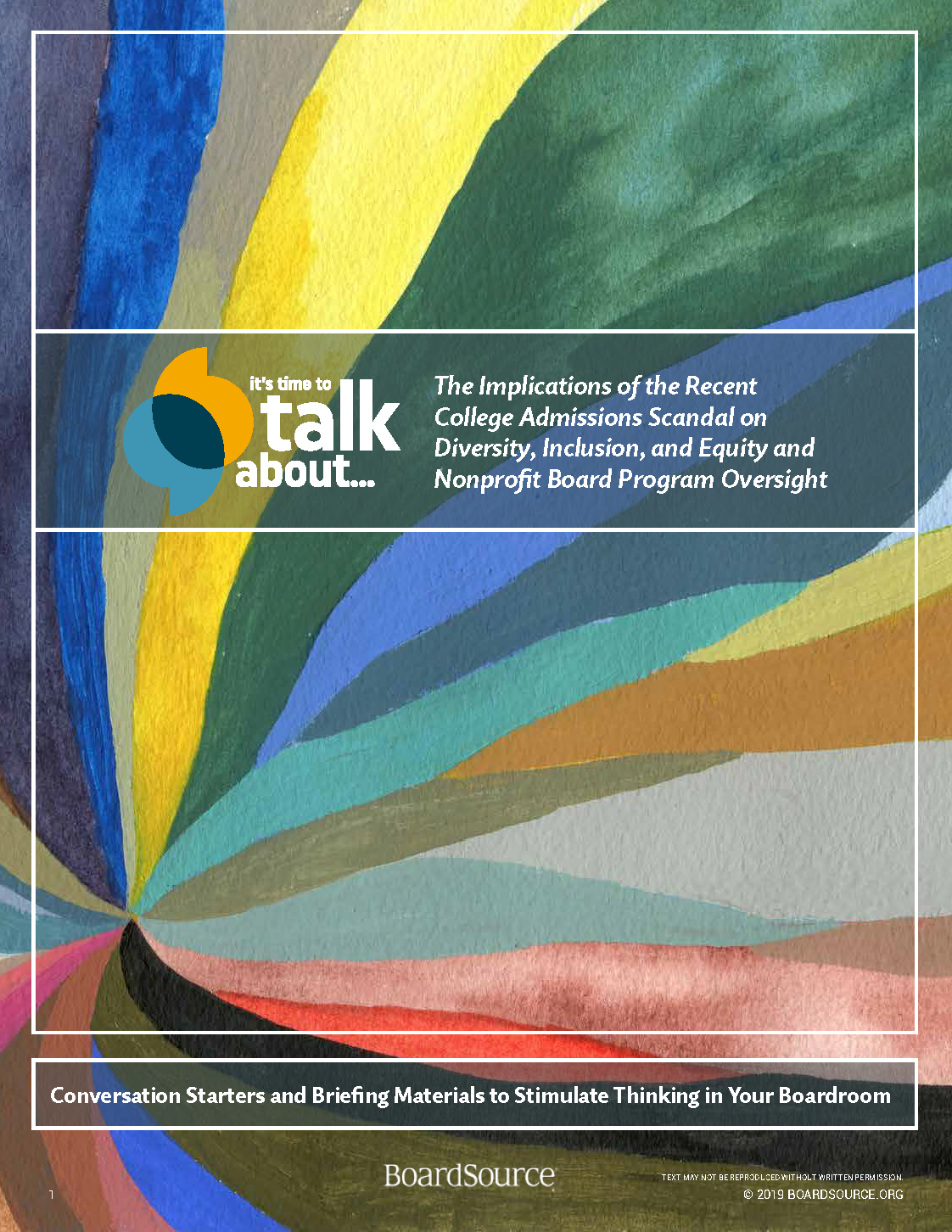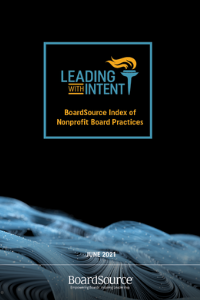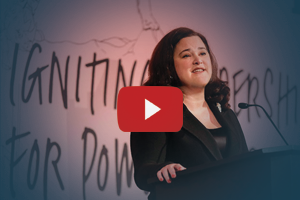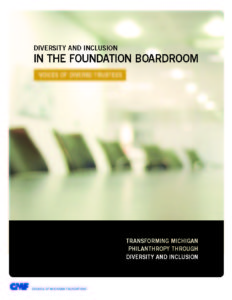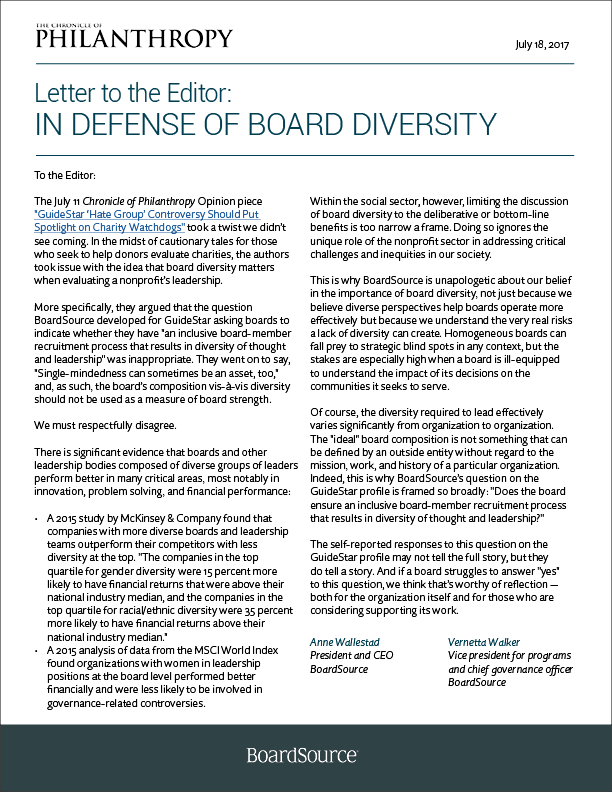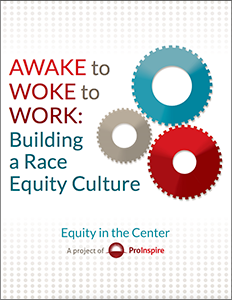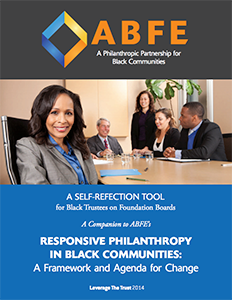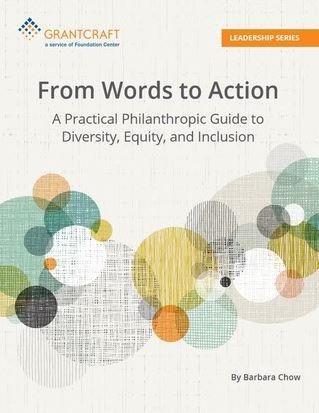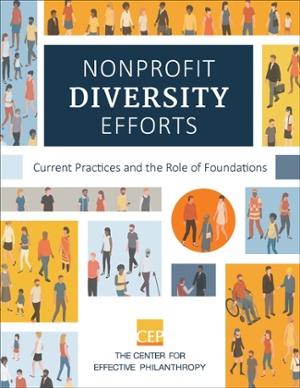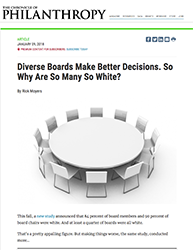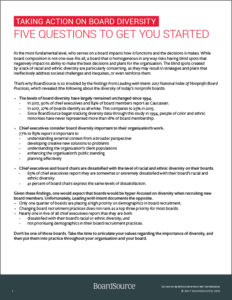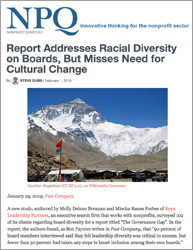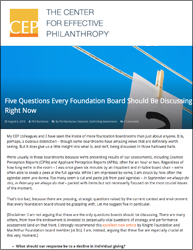Nonprofit boards are the decision-making body at the highest level of organizational leadership, and play a critical role in prioritizing, supporting, and investing in nonprofit board diversity, inclusion, and equity.
As stewards of the public good, all social sector organizations, regardless of mission, are called on to embrace and celebrate our common humanity, and the inherent worth of all people. In doing so, we must also acknowledge that a climate of growing intolerance and inequity is a challenge to our democratic values and ideals. Divisions along economic, racial, religious, and political lines have created an increasingly polarized society in need of healing. The complex issues and dynamics at the intersection of race, class, and gender call for deeper thinking as we seek to understand each other.
Importance of Board Diversity, Inclusion, and Equity
As evidenced in Purpose-Driven Board Leadership boards represent and govern our organizations on behalf of communities. Who is on the board can drastically change how the board operates and what role it plays.
Leading with Intent shows that “almost half of executives report that they do not have the right board members to “establish trust with the communities they serve.” Only a third of boards (32%) place a high priority on “knowledge of the community served,” and even fewer (28 percent) place a high priority on “membership within the community served.”
Whether in the hiring of the executive, the building of the board, the determination of strategy, the allocation of resources, or the goal of serving the community with authenticity, the board’s leadership on diversity, inclusion, and equity is paramount. Boardsource believes that social sector organizations are better able to do this work effectively and with authenticity when they are led by boards that are:
- Diverse: The individual leaders who compose nonprofit boards are a reflection of an organization’s values and beliefs. The composition of the board communicates who it believes should be empowered and entrusted with its most important decisions. While board composition is not one-size-fits all, a board that lacks diversity in any way may have deficiencies that negatively impact its ability to make optimal decisions and plans for the organization. Lack of racial and ethnic diversity are particularly concerning as they may result in ineffective ways to address societal challenges and inequities and may even reinforce them. Social sector organizations can better achieve their missions by drawing on the skills, talents, and perspectives of a broader and more diverse range of leaders; the diversity of viewpoints that comes from different life experiences and cultural backgrounds strengthens board deliberations and decision-making.
- Inclusive: The most effective boards work to build a culture of trust, candor, and respect — none of which is possible without a culture of inclusion. Boards that cultivate an inclusive culture ensure that all board members are encouraged to bring their perspectives, identity, and life experience to their board service. An inclusive board welcomes and celebrates differences and ensures that all board members are equally engaged and invested, sharing power and responsibility for the board’s work, the organization’s mission and its purpose.
- Equity-focused: Boards play a critical role in helping organizations understand the context in which they work and how best to prioritize resources and strategies based on that reality. An awareness of how systemic inequities have affected our society and a willingness to interrogate the organization’s role in perpetuating those inequities creates powerful opportunities to deepen the organization’s impact, relevance, and advancement of the public good. It also enables boards to take a step back and identify any areas that may lead to flawed strategies.
BoardSource invites and challenges you to reflect on your organization, consider its journey, identify areas of improvement, and take action to make improving diversity, inclusion and equity a top priority.
Taking Steps to Change Your Nonprofit Board Diversity, Inclusion, and Equity
BoardSource has made a commitment to diversity, equity, and inclusion, for ourselves and for the social sector. BoardsSource firmly believes in the importance of each, understanding the significant harm that can result from their absence. The stakes are especially high when a board lacks the understanding to comprehend the impact of its decisions on its organization, mission, and community.
Read more about BoardSource’s Commitment to Diversity, Inclusion, & Equity on BoardSource’s Blog:
Highlighted Research, Articles, and Resources
The following resources have been curated by BoardSource and reflect what we believe to be some of the best thinking and practical advice to boards on diversity, inclusion, and equity – and the relationship between the three – across the social sector (and beyond). While some of these resources apply to specific sub-sectors (higher education, foundations, etc.), we believe that all of them have relevance to the work of nonprofit boards of all kinds.
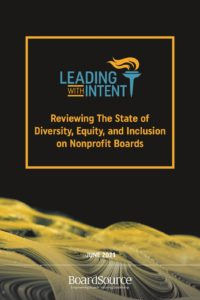
Leading with Intent: Reviewing the State of Diversity, Equity, and Inclusion on Nonprofit Boards
BoardSource

Addressing Challenges and Opportunities to Diversity & Inclusion
David Williams at BoardSource Leadership Forum in 2017
Read what BLF attendees shared in discussion groups following.
Anne Wallestad, BoardSource President & CEO, at BoardSource Leadership Forum in 2017
Read more about BLF 2017

Different is Better: Why Diversity Matters in the Boardroom
Russell Reynolds Associates
From Words to Action: A Practical Philanthropic Guide to Diversity, Equity, and Inclusion
GrantCraft
Nonprofit Diversity Efforts: Current Practices and the Role of Foundations
The Center for Effective Philanthropy
Diverse Boards Make Better Decisions. So Why Are So Many So White
Rick Moyers, Chronicle of Philanthropy
Report Addresses Racial Diversity on Boards, But Misses Need for Cultural Change
Nonprofit Quarterly
Other Articles & Perspectives
Can we talk about…? Podcast | Philanthropy Northwest and The Giving Practice | 2023
A podcast on leading for racial equity in philanthropy. For leaders working towards practicing racial equity at the board level Can we talk about…? offers not a roadmap or checklist but stories – honest reflections, bold moves, aha moments, moments of fear, discomfort, joy and levity – to guide and support you as you navigate the complexities of this work.
The (White) Elephant in the (Board) Room: How White Board Members Can Step Up By Stepping Aside | Sapna Strategies | August 3, 2020
Sapna Sopori shares how need to actively examine our board rooms, not only for who we want to bring into the room but who is already in the room and if they should still be there.
Racial Equity Tools Glossary | Racial Equity Tools | MP Associates | Center for Assessment and Policy Development, and World Trust Educational Services | 2019
Racial Equity Tools has created a glossary of terms to create a shared understanding of words to enhance the way we talk about race.
Racial Equity and Philanthropy: Disparities in Funding for Leaders of Color Leave Impact on the Table | The Bridgespan Group | Cheryl Dorsey, Jeff Bradach, Peter Kim | 2020
This research, from Echoing Green and Bridgespan, lays bare the racial disparity in today’s funding environment and argues that population-level impact cannot happen without funding more leaders of color.
Overcoming the Racial Bias in Philanthropic Funding | Stanford Social Innovation Review | Cheryl Dorsey, Peter Kim, Cora Daniels, Lyell Sakaue & Britt Savage | 2020
Racial bias creeps into all parts of the philanthropic and grantmaking process. The result is that nonprofit organizations led by people of color receive less money than those led by whites, and philanthropy ends up reinforcing the very social ills it says it is trying to overcome.
Owning My Whiteness | Northwest Area Foundation | Kevin Walker | 2019
Kevin Walker reflects on his diversity, inclusion, and equity journey by sharing a personal experience that he has begun thinking about with a new lens.
In this blog post, the Community Foundation for Greater Buffalo’s president and CEO and governance committee chair discuss the importance of board diversity in advancing their organization’s mission.
Why Money Shouldn’t Trump Mission When Choosing Board Members | Chronicle of Philanthropy | Isa Catto | 2018
Emphasizing diversity when selecting board members should also include economic diversity. While it may be tempting to fill a board with high-net-worth individuals, it is not always the best choice for the board or your organization’s mission.
Donor Stories: Grantmaking that is “With” and not “For” | Center for Effective Philanthropy | 2018
What if the beneficiaries of the hardworking organizations that foundations serve were represented among foundation leadership?
Moving to Action on Board Diversity | Center for Nonprofit Excellence | 2018
Thoughtful consideration of the questions in this article can help your board move beyond good intentions to develop an action plan. And action is needed, because decades of evidence show the value of diverse boards and suggests that diversity won’t happen without intentionality.
California’s Nonprofits Still Not Quite Diverse, Despite Leading The Nation | Fast Company | 2018
A new report compares California’s reputation as a diverse, progressive bastion to the hiring and treatment of people of color in its nonprofits.
Let’s Stop (Just) Talking About Nonprofit Board Diversity | HuffPost | Anne Wallestad | 2017
In the social sector, a board that lacks racial and ethnic diversity risks a dangerous deficit in understanding on issues of critical importance to the organization’s work and the people it serves.
Accelerating Nonprofit Board Diversity | Nonprofit HR | 2017
In our current political and social climate, it is more important than ever that nonprofit organizations step up to serve those in need and innovate for the health and sustainability of their missions. Developing truly diverse and inclusive boards is a critical step toward achieving these goals.
BoardSource Webinar: The Declining Diversity of Nonprofit Boards and What to Do About It | The Nonprofit Quarterly | 2017
BoardSource’s Leading With Intent report shows that diversity has actually declined on nonprofit boards. Is this a question of ineffective or inept action? Or are boards simply not prioritizing diversity? Find out in this exclusive webinar.
7 things you can do to improve the sad, pathetic state of board diversity | Nonprofit and Friends | 2017
BoardSource just released its report on board diversity, and the statistics are frustrating, disappointing, and somewhat anger-inducing….The lack of diversity on boards is no longer just annoying. It is a critical issue.
BoardSource: Nonprofit Board Diversity Hasn’t Improved in Decades | Association Now | Ernie Smith | 2017
A new report says that more than 80 percent of nonprofit board members are white, a number that looks remarkably similar to the group’s findings from a 1994 index survey. It’s time for words to be backed up by action to improve board diversity, according to BoardSource’s CEO.
BoardSource Finds a New Platform for Action in the Face of Declining Diversity | Nonprofit Quarterly | Ruth McCambridge and Cyndi Suarez | 2017
After a fraught last few years in terms of national attention to issues of race, one would expect that nonprofit boards would demonstrate at least a modicum of advancement in the realm of diversity. The comparative statistics shown in Leading with Intent: 2017 Index of Nonprofit Board Practices tell a different story.
Recruiting for Board Diversity | Jan Masaoka
We recognized that for organizations of color, women’s organizations, immigrant organizations, and others, demographic diversity may be inappropriate, or framed differently. In this article, we build from there for an organization that knows what board members need to do, and as a result, who they might need to be.
The Face of Nonprofit Boards: A Network Problem | Tivoni Devor, manager of partnerships and outreach, Urban Affairs Coalition (Nonprofit Quarterly)
Within BoardSource’s 2015 governance index, “Leading with Intent,” there lies an interesting paradox when it comes to board diversity. Forty-five percent of the boards and 69 percent of the CEOs surveyed are dissatisfied with their board’s diversity. If boards are so dissatisfied with their racial makeup, why is so little being done to improve these numbers? These survey results leads one to think it must at least partially be connected to how board members are recruited.
How to Make Socioeconomic Diversity a Priority in Your Board Search | Drew Lindsay, The Chronicle of Philanthropy
Organizations need to make recruitment a more holistic, intentional process, champions of diversity say. Too often, charities do casual searches that rely on scanning candidates’ credentials and tapping board members’ personal networks. Instead, they need to purposely seek individuals who might never hit the radar of a traditional search.
How to Catch a Unicorn: Diversify Your Nonprofit Board Like You Mean It | Jermaine L. Smith, development director, Educare New Orleans (BoardSource blog)
I am a millennial. I am a black man. I am a fundraiser. I am a board member. These are some of the ways I describe myself. Yet, as my experience in the nonprofit sector has deepened, I have discovered that many board leaders describe me a different way: I am a unicorn.
The Nonprofit Racial Leadership Gap: Flipping the Lens | Cyndi Suarez, senior editor, Nonprofit Quarterly
Building Movement Project’s just-released leadership report (June 2017), “Race to Lead: Confronting the Racial Leadership Gap,” highlights what many of us know: The nonprofit sector is experiencing a racial leadership gap.









